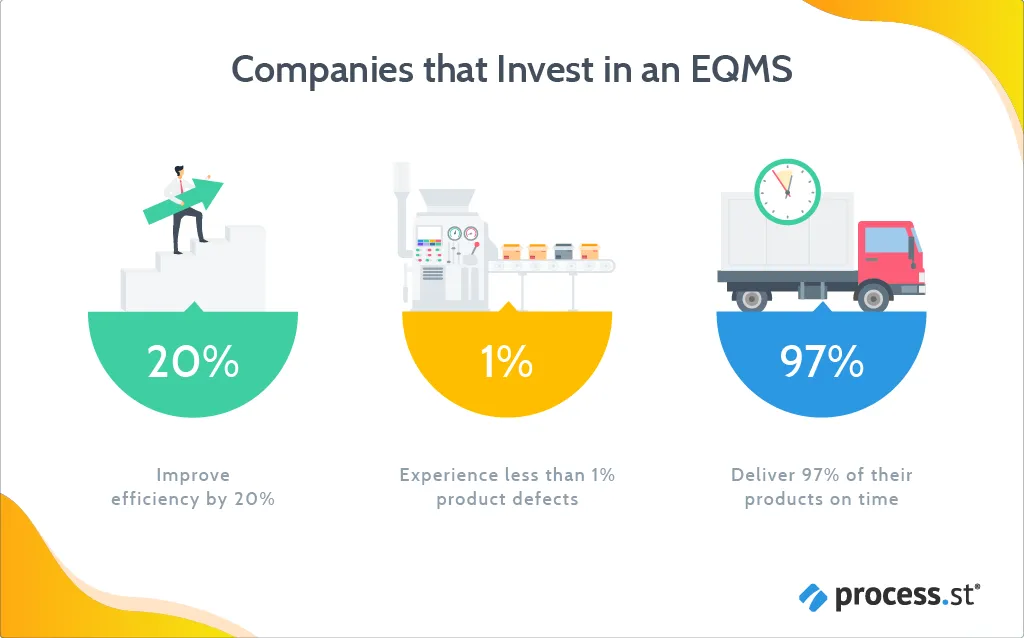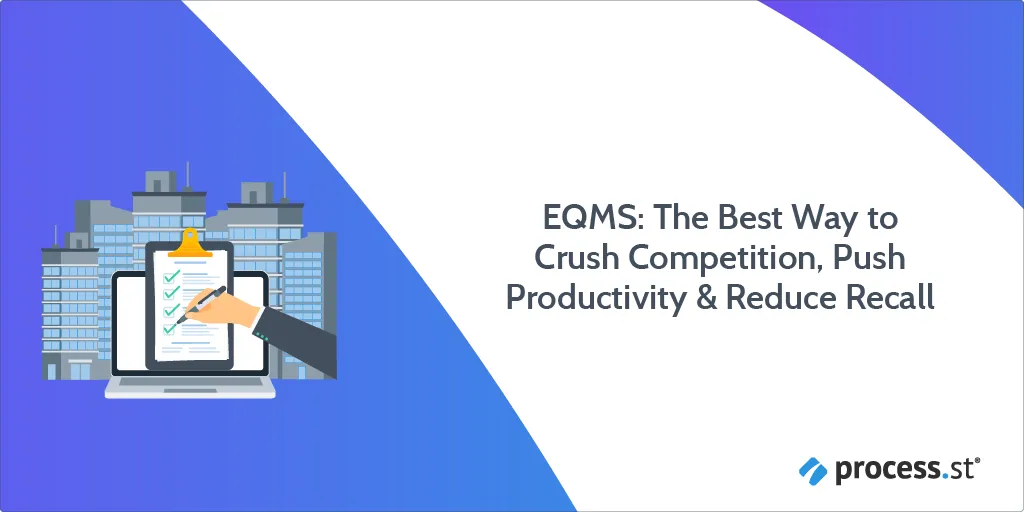EQMS: The Best Way to Crush Competition, Push Productivity & Reduce Recall
Blog: The Process Street Blog

Would you eat a McDonalds Big Mac that was out-of-date, had been dropped on the floor, and made with a stranger’s bare hands?
No! Me neither.
Unfortunately, that’s what thousands of people in China, unknowingly, did.
Back in 2015, the Chinese meat suppliers for McDonald’s were secretly filmed and caught:
“Handling meat and chicken with their bare hands, taking meat that had fallen on the floor and adding it back on to the production line…and forging production dates on beef patties.” – ET2C, Lessons on the Importance of Quality Control Checks
Around 4,300 McDonalds beef patties were tested and found to be out-of-date and contaminated with bacteria.
As a result, over 2,000 McDonald’s outlets across Asia were dramatically affected. The reputation of McDonald’s and their meat supplier was irreversibly damaged, and McDonald’s saw a 7.3% drop in sales.
McDonald’s was definitely not ‘lovin it’.
If only they’d used Enterprise Quality Management Software (EQMS) to regulate their supplier’s meat handling processes and control the quality of the produce they were delivering.
Companies who use EQMS to manage quality, experience fewer product quality issues (less than 1%), and improve their productivity by 20%.
Keen to find out more? Join me in this Process Street post as we run through the following:
- EQMS: What is it & how does it work?
- EQMS: Who uses it?
- EQMS: Is it just for regulated organizations?
- EQMS: What are its downfalls?
- EQMS: Is there another option that’s quick to implement & easy to use?
Let’s make our way through the golden arches and get started! 



EQMS: What is it & how does it work?
In its simplest form, EQMS (Enterprise Quality Management Software) is a technical solution to help organizations manage the quality of what they’re producing.
It’s used by enterprises to make sure they follow industry regulations, observe best practices, and consistently produce high-quality products that keep their customers happy.
How does EQMS do that?
EQMS, as the name suggests, is a piece of quality management software that joins an organization’s quality control processes together, and collects and displays key quality control data from those processes. Data on metrics such as the number of inaccuracies, maintenance frequencies, and speed of production enables organizations to spot issues, stay compliant, and keep quality levels consistently high.
“EQMS centralizes, standardizes, and streamlines quality content and processes throughout the value chain, enabling cross-functional communication and collaboration on critical issues” – CDN2, Unlocking the Value of Enterprise Quality Management Software
EQMS: Who uses it?
Any organization that gives a damn about quality would benefit from implementing EQMS. However, only 20% of companies are currently using an EQMS to control and manage quality. It’s generally only adopted by corporations that are heavily regulated. Companies in the food, financial or aerospace industries, for example, that need to be compliant with industry standards and regulations such as ISO 22000, AS9100, or ISO 9001.
“To stay competitive, more and more organizations are turning to EQMS to meet quality standards and maintain compliance with quality regulations imposed by the FDA, ISO, EMEA, and other similar regulatory bodies.” – MasterControl, Enterprise Quality Management Software Systems (EQMS)
Why do regulated companies turn to EQMS?

Regulated companies, like JP Morgan or Boeing for instance, face the same battles that non-regulated companies face. They’re under constant pressure to make a profit, stay competitive, and cut costs. But on top of all that, regulated companies also face strict regulations, frequent audits, and hefty fines if they fail to meet regulatory expectations.
Maintaining compliance while trying to run a successful business is difficult for companies that rely on outmoded tools, manual processes, and a fragmented approach to quality management.
Regulated companies need a reliable system that saves them time and takes the stress out of managing quality. They need something that can automate, streamline, and connect all their quality processes, so they can focus on accelerating speed to market, reducing costs, improving efficiencies, minimizing risk, and ensuring compliance.
But what if you’re not in a heavily regulated industry? Is EQMS the right solution for you?
EQMS: Just for regulated organizations?
I’ve got a couple of questions for you.
1. What makes a business successful?
Is it:
- a) Keeping customers happy
- b) Crushing the competition
- c) Efficient, error-free manufacturing processes and cost reductions
Of course, it’s all three, right?
2. And how do you make sure you achieve all three and, therefore, become a successful business?
Is it:
-
a) Focus on quality
b) Focus on quality
c) Focus on quality
I think you’ve got it! To keep your customers happy, your competition at bay, and your manufacturing processes efficient, error-free, and cost-effective – you need to focus on quality.
Which is where EQMS comes in.
Not only does EQMS make it easier for organizations to stick to standards and regulatory requirements, it also allows them to:
- Monitor and control all of their quality management processes, from one central place
- Assess how their organization is performing as a whole, in real-time
- Identify and resolve bottlenecks and pain points in their design and production methods
- Make informed decisions around quality management processes
- Standardize operations across the entire organization
- Achieve operational excellence throughout the product life cycle
Investing in EQMS allows organizations to control and manage quality quickly, easily, and with less risk. It allows them to make sure their customers are happy, their processes are efficient, and competition is outpaced.

“Not having an EQMS creates risk by forcing your company to rely on manual processes. Ultimately, not implementing EQMS costs manufacturers money by encouraging a reactive approach to quality.” – CEBOS, The Risks and Costs of Not Having EQMS
If your company is dealing with time-consuming paper processes, disparate databases, or poor supplier quality, you should consider implementing Enterprise Quality Management Software.
But, wait a second.
“While more companies are talking about adopting an EQMS system, few are making progress when it comes to actually budgeting for and implementing such a system.” – PharmaManufacturing, Don’t Slow Your EQMS Adoption Roll
EQMS: What are its downfalls?
As great as EQMS sounds, there are a few barriers to implementation that we need to consider.
EQMS downfall # 1: It’s overly expensive & overly complicated
There are so many EQMS solutions out there, all offering different benefits at varying prices. But, to give you a general idea, implementing a standard, robust EQMS system, can cost you anywhere from $30,000 to $75,000 per year.
But it’s not only the annual cost you have to consider.
EQMS systems are also renowned for being complex, burdensome, and difficult to use. In fact, a recent Deloitte study identified that some manufacturers are spending up to $100,000 and 116 workdays per year trying to comply with overly complex Enterprise Quality Management Software systems.
So, EQMS can be costly, both in terms of initial implementation and upkeep, and also everyday usage.
EQMS downfall # 2: It takes a long time to implement
The implementation of new software into an organization is often filled with teething problems and unforeseen complications. It can be a steep learning curve for all involved. This is especially true for larger enterprise organizations, and implementing an EQMS solution is no exception.
The installation of EQMS systems often exceeds the expected delivery time and organizations can encounter numerous issues and frustrations as they adapt to the new way of working.
EQMS downfall # 3: One size does not fit all
Many organizations will willingly spend the time and money implementing an all-singing, all-dancing EQMS system because they’re under the impression that it will revolutionize everything.
But, as many EQMS systems come as out-the-box solutions (unless you invest a lot of time and money in a custom platform), organizations are often left with an incredible piece of software that is completely above and beyond what they need.
If the EQMS solution doesn’t fit with organizational goals, budget, structure, or stage of growth, companies are likely to waste money, confuse their workforce, and be left with a complex tool that loses any and all actionability as a result.
“A system is only as good as how its users can proficiently utilize it for various operations.” – CloudSecureTech, What is EQMS (Enterprise Quality Management Software)?
To summarize, although the benefits of having an EQMS system make it a must-have for many large regulated enterprise organizations, EQMS does have some hefty downfalls. It can be complicated and expensive to use, it requires lots of training, and it can take a long time to implement and become beneficial to organizations.
EQMS: Is there another option that’s quick to implement & easy to use?
There is.
“A narrow focus on ‘hard’ quality management tools can be at the expense of the support of ‘soft’ quality management practices, which can help to more effectively embed a ‘culture of quality’ across an organization” – Cognidox, QMS, eQMS or BMS? What’s the Difference?
If the hardcore, complex EQMS systems don’t feel like the right solution for you, there is another option.
Process Street is a powerful yet easy to learn no-code tool that allows you to create, document, monitor, and manage all the processes within your organization. Basically, it’s super-powered checklists.
If a quality management system allows you to oversee your inputs and outputs in terms of a quantifiable “quality”, Process Street allows you to track and manage all of your internal processes in the form of checklist templates. You can effortlessly build and maintain all of your internal procedures, and see who is working on them in real-time. Rich form fields mean you can track detailed data and information and have the results of each process output to a spreadsheet or .PDF via one of 1,000s of integrations.
Before I go any further, watch this video from managed services provider TechMD to hear about how they use Process Street to manage their internal processes. You could also read this article to find out a little more about what Process Street is and how it can make your life easier.
Although it’s not an “official” EQMS system (whatever that is), Process Street can help you to achieve the same objectives as EQMS can, in terms of managing quality.
Take a look at the below ISO 9001 internal audit process for quality management systems as an example. This process template was created to help organizations meet ISO 9001:2013 audit criteria:
Click here to access the ISO 9001 Internal Audit Checklist for Quality Management Systems!
(Log in and add this template to your account, or sign up for a free trial, if you don’t have one yet).
So, as you can see, you can create templates for your quality control processes to help you standardize operations across the entire organization.
You can create tasks and assign them out to your workforce, to make sure they are following best practices, or meeting required standards as they work through their processes.
You can connect the process templates you create to the platforms you use regularly, via Zapier, Webhooks, or API integration. This means you can record, send, and store key data from your processes instantly and accurately.
The checklist dashboard will allow you to monitor all your quality management processes, from one central place. This will enable you to assess how your organization is performing as a whole, in real-time. It will also help you to identify and resolve bottlenecks in your design and production methods, and can inform your decisions around quality management processes.
And, to make life easier, you also have access to the Process Street template library, which is filled with thousands of pre-made quality control templates that you can use, for free.
Templates like these for example:
AS9100D Audit Checklist
Use this checklist as a framework to help you conduct an effective audit on the implementation of the AS9100D aerospace quality management standard.
Click here to access the AS9100D Audit Checklist!
FSSC 22000: ISO/TS 22002-1 Internal Audit Checklist
Use this checklist to help you meet the regulatory requirements set by pre-requisite programs such as ISO and 22002-1, and make sure you’re supplying safe food and beverages.
Click here to access the FSSC 22000: ISO/TS 22002-1 Internal Audit Checklist!
You can use any of the above templates as they are, or you can customize them. Use the below super-powered features to make your processes fit your specific organizational goals, objectives, structure, and industry:
- Stop tasks

- Dynamic due dates

- Task permissions

- Conditional logic

- Approval tasks

- Embed widget

- Role assignments


- Webhooks

- Many, many more

Keen to read more? We’ve written on quality management a lot in the past. Below you can find some of our choice articles.
Essential EQMS reading
You can find more posts like this, and the ones below, in our Process Street blog. Go ahead, fill your boots!
- ISO 9001: The Ultimate QMS Guide (Basics, Implementation, ISO Templates)
- Best QMS Software for Quality Management Systems: Which is Right for You?
- What is Quality Management? The Definitive QMS Guide (Free ISO 9001 Template)
- How to Use The Deming Cycle for Continuous Quality Improvement
- Quality Control: How to Get It Right With 19 Free Templates
- Total Quality Management (TQM): Improve Processes & Keep Customers Happy
Before we close out, I have one final observation I’d like to leave you with.
Remember earlier, when Deloitte established that some organizations were spending up to $100,000 and 116 workdays per year, trying to comply with overly complex, Enterprise Quality Management Systems?
Well, in another Deloitte survey, they found that if organizations simplified and centralized their quality management systems, they could reduce that to only 67 workdays and $51,000 per year.
Need I say more?

(P.s. McDonald’s are still using the same meat suppliers that they were in 2015, so I’d stay away from Big Mac’s in China if I were you!)
We’d love to hear about your experience with, or opinions about, EQMS. Talk to us in the comments below! Who knows? Your thoughts could get featured in an upcoming article!


